Serbia is a beautiful country in southeastern Europe which, for some reason, is often overlooked by travellers visiting countries of the former Yugoslavia, who tend to visit Croatia and Bosnia and Herzegovina. However, I’m here to persuade you that Serbia is a worthy destination with plenty to see and do.
There are five impressive National Parks to visit throughout the country, over 20 ski resorts in the mountains and many great cities in Serbia. Each city has its highlights, and most are steeped in history going back hundreds, even thousands of years. In many of these Serbian cities, you will find castles, fortresses, museums, churches and monasteries.
Those more interested in the present will enjoy the many music and cultural events held throughout the year in Serbia. If you love to shop, Serbia has become a shopping paradise since the wars of the 1990s. In many cities, you can find clothes and jewellery from the top brands to local designers.
Café life is widespread, and people sit outside during the summer months. There are also plenty of restaurants with Serbian and other cuisines in the larger cities, such as Italian, Mediterranean, and Chinese. Belgrade has vegetarian and vegan restaurants, but you may struggle in the smaller towns if you don’t eat meat.
Serbia has a moderate continental climate with hot summers and cold winters. It is an excellent place to ski in the winter as a change from the most known resorts. Serbia is landlocked, but there are beaches by the lakes and rivers. Here are the top 20 cities to visit in Serbia.
Contents
Cities in Serbia
Best Tours
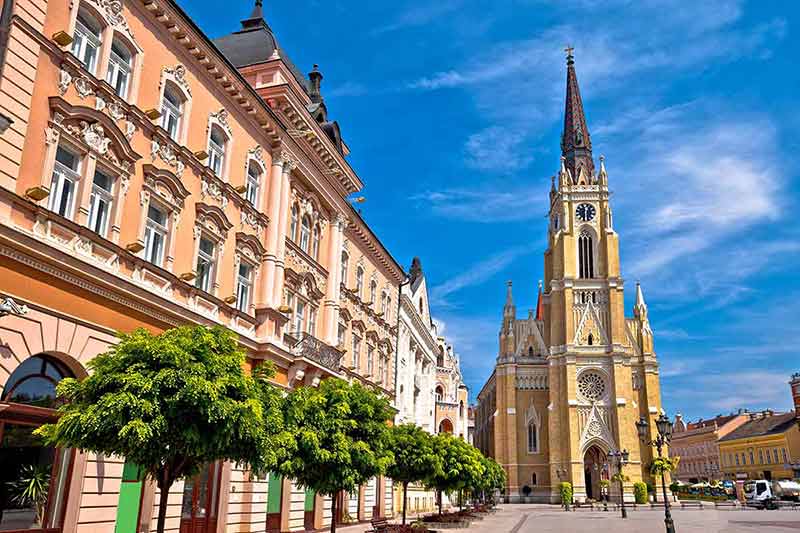
- From Belgrade: Danube Day Trip with Wine and Brandy Tasting – visit fortresses, wineries and Smederevo on this classic cruise along one of the world-famous rivers.
- Belgrade: Sunset Sightseeing Cruise – with a drink in hand, enjoy the bright lights of Belgrade from the water as the city lights up like a fairyland.
- From Belgrade: Novi Sad and Sremski Karlovci – a delightful full-day tour exploring these charming cities.
20 Serbian Cities To Visit
1- Belgrade
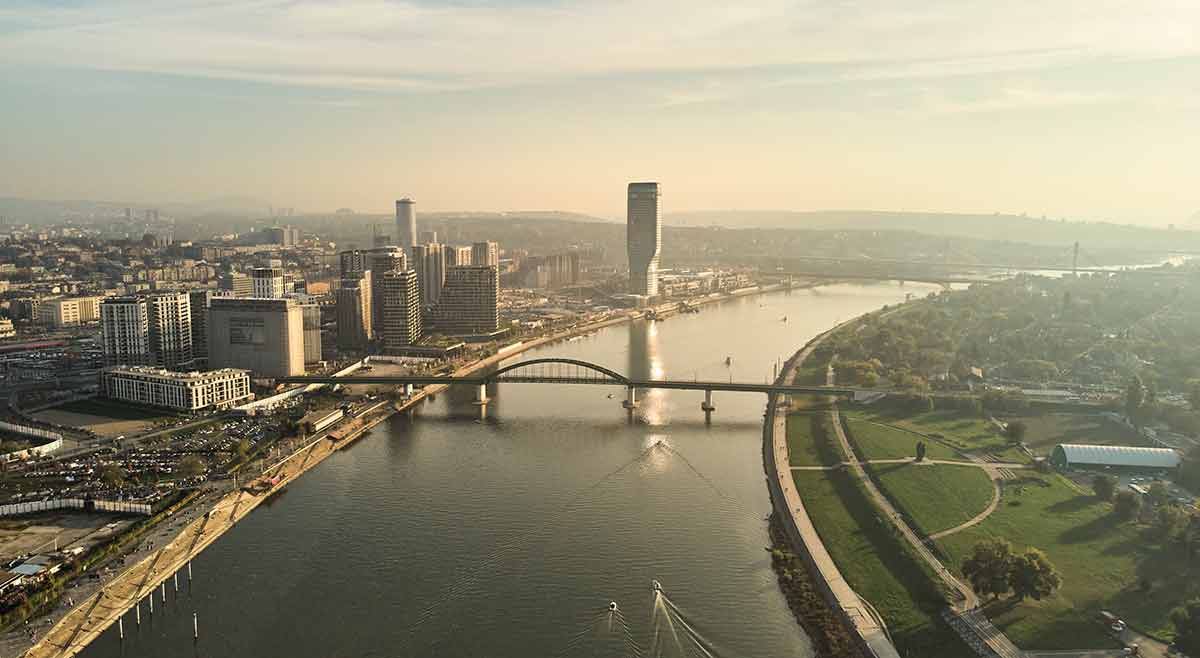
Belgrade is a city at the confluence of the Danube and Sava rivers.
Imposingly standing where the two rivers meet is the Beogradska Tvrdjava, an impressive fortress that held an important strategic position during different occupations between the 2nd and 18th centuries.
First built in the 2nd century, when the Romans occupied the country, it was later destroyed and rebuilt many times during the Byzantine, Ottoman, and Austro-Hungarian Empires.
Today, you will find an Upper and Lower Town and a beautiful park called Kalemegdan.
It was once the site of many battles but is now a peaceful place to walk.
Many signs of Ottoman rule in the Lower Town include the Hammam (Turkish Bath) and a well-preserved monument of Damad Ali Pasha, a 17th-century Ottoman general and Grand Vizier.
There is a military museum in the Lower Town.
Museums abound in Belgrade, and the oldest and largest, The National Museum of Serbia, is the one to visit if you don’t have that much time in Belgrade.
It contains over 400,000 archaeological, historical, and artworks from Serbia and the central Balkans.
Serbian Orthodox Christianity is the main religion in the city, and you will find many Orthodox churches.
Try to get to the Saint Sava Temple, the largest Orthodox church in the Balkans.
It has some beautiful frescoes depicting the life of Christ.
If you are craving a little beach life, do not worry.
On the Sava River, there is an island called Ada Ciganlija (Gypsy Island) which has been artificially turned into a peninsula.
You can swim, sunbathe, water ski, and it is buzzing with life at night.
The nightlife in Belgrade will suit those who like to party all night, with bars and clubs spilling onto the streets in the hot summer months.
Tee National Museum Of Serbia is at Trg Respublika 1a 104303.
Recommended tours:
- Top Attractions & Belgrade Neighborhoods Big Tour
- Belgrade: Sunset Sightseeing Cruise with Drinks
- Red Belgrade Communist Tour
2- Novi Sad
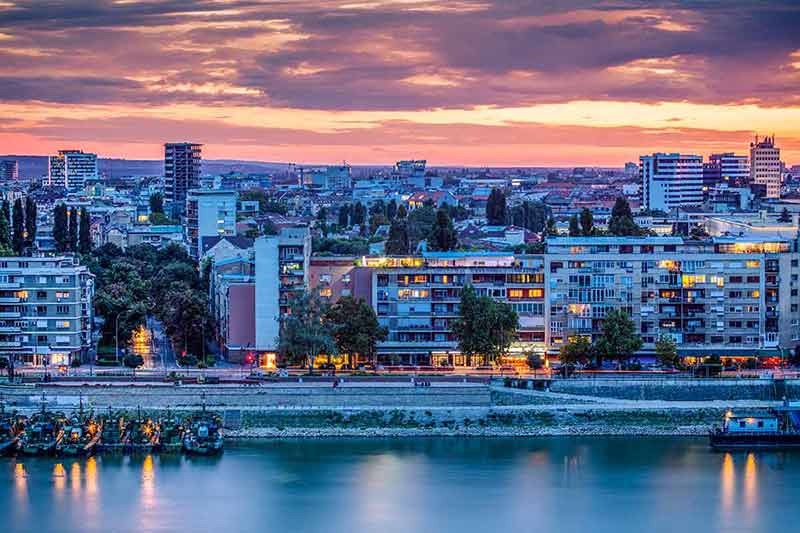
Novi Sad, Serbia’s second-largest city, is set on the Danube River banks in the country’s north.
As in Belgrade, a magnificent fortress overlooks the city.
It dates back to the 17th and 18th centuries and has a lovely clock tower and a network of underground tunnels.
Take a guided tour of the tunnels between 1 and 2 km (0.6 – 1.2 miles) of the 20 km network.
Be warned, however, that they are dark and damp, and if you suffer from claustrophobia, this probably isn’t for you.
They were originally defensive galleries but were eventually turned into prisons.
You can imagine how awful it would have been to be kept there.
The Fortress holds the annual EXIT music festival, and in July, you should try and get tickets to this top music festival in Europe.
Novi Sad’s many museums and art galleries include the Gallery of Matica Srpska, which houses modern Serbian Art, and the Museum of Novi Sad, which depicts the city’s history.
The city has picturesque spots like the Varadin Bridge, which crosses the Danube.
You can enjoy cruises on the river and see the city from a different viewpoint.
As in Belgrade, the nightlife is good, with plenty of cafes, clubs, pubs, and discos offering music from rock to pop to traditional tamburica music.
Recommended tours:
- From Belgrade: Novi Sad & Sremski Karlovci Full-Day Tour
- Novi Sad: The city center and fortress Private Walking Tour
The Gallery of Matica is at Trg Galerija 1 21101.
The Museum of Novi Sad is at Trg Slobode 1 21101.
3- Subotica
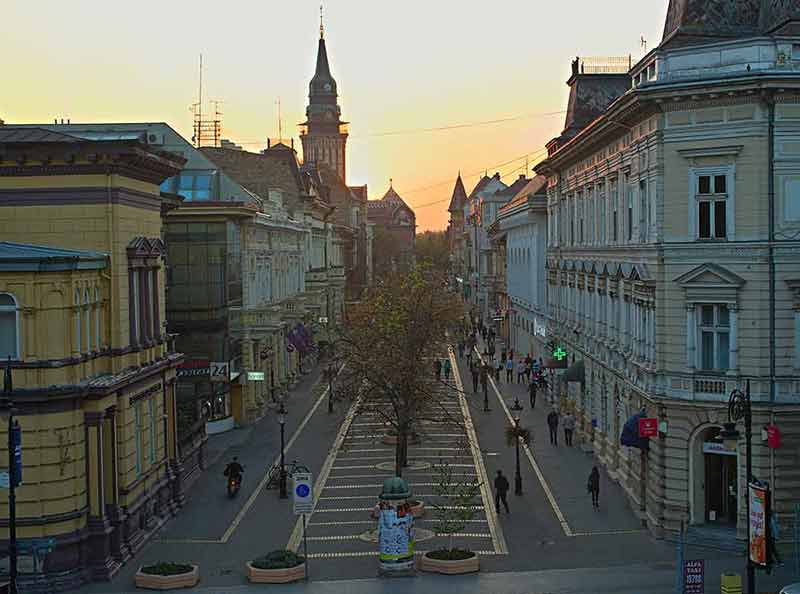
Subotica, close to the Hungarian border, was once an important city within the Austro-Hungarian Empire and was filled with rich and influential people.
Now part of Serbia, this city still exhibits the fine Art Nouveau architecture created during that time.
The city is vibrant and multicultural.
It has a large Croatian and Hungarian population and my Hungarian family lived near Subotica.
I spent many teenage summers in the area, so I can recommend it.
If you are interested in Art Nouveau, the 1903 synagogue is worth visiting.
It has a dome painted in gold and there are motifs of carnations, peacock feathers, and tulips both inside and outside the buildings, traits of Hungarian Art Nouveau.
Visit the Municipal Museum, also an Art Nouveau building, which has a history exhibition on the ground floor, while an art gallery upstairs showcases regional art.
Subotica is the ideal place for a glass of wine as the sandy soils of the surrounding area, the hot summers, and the cool winters are ideal for grape growing.
There are six wineries close to Subotica, and the tourist board arranges day-long trips at the weekend, allowing you to enjoy some wine without worrying about driving.
The local wines you should try are the red Kadarka and the white Kevedinka.
On the fringe of the city, nestled among vineyards, is Palic, a lake resort.
If you need a break from sightseeing, come here and laze on the beach or swim.
You can also sail, canoe, and fish.
Recommended tour:
The Synagogue is at Trg Jakaba I Komora 6 24000.
The Municipal Museum is at Trg Sinagoge 24000.
4- Vranje
Let’s head south to Vranje, a city with a long history.
Many other nations, such as the Roman Empire and Bulgaria, have ruled it; however, the Ottoman Empire had the most influence on the city.
You will see attractive mansions designed in the Turkish style and hammams.
Visitors are attracted to Vranje to see the spectacular 11th-century fortress 3.5 km (2.2 miles) northeast of the city.
Markova Kale is built on a ridge 750 metres ( 2,460 feet) high between the mountains.
You can explore the ruins of the fortress and the church and have spectacular views of the surrounding countryside.
In Vranje, the Museum of Bora Stankovic is worth a visit.
Bora Stankovic was a famous Serbian writer of realism novels and short stories born in Vranje.
The museum shows some of his furniture, family photos, and books.
If you are a romantic, go to the Beli Most or Love Bridge, although a sad story surrounds it.
Legend says it was built in memory of an unhappy love between a Turkish girl and a Serbian shepherd.
5- Leskovac
Leskovac is another city in southern Serbia, famous for its October ‘Rostiljijada’ festival.
It is a carnivore’s paradise.
The central boulevard is closed off and becomes an enormous barbecue with smells of searing meat and smoke wafting in the air.
It attracts Serbians from all over the country for the feast.
If you are vegan like me, I wouldn’t go to Lescovac during the festival!
During the summer, which is a lovely time to visit, another festival is held in the city that celebrates Serbian traditions.
The main boulevard is closed to road traffic and musicians and other street performers entertain the crowds.
There are religious and secular parades, and concerts and dance performances are held in the main hall of the Sop-Dokic House.
While in Leskovac, you should visit the National Museum, which houses 33,000 artefacts relating to archaeological, ethnography, and art from the city and the surrounding Jablanica District.
Just west of Lescovac are the ruins of a Byzantine city built during the time of Justinian 1 in the 6th century.
There are still interesting things to see here, such as baths, a sewage system, fortifications, and a basilica with some beautiful mosaics.
The National Museum is at Stojana Ljubica 2 16000
6- Pancevo
Pancevo is only a short drive from Belgrade and is a beautiful city filled with Neoclassical mansions built during the time of the Austro-Hungarian Empire.
There are some lovely 19th-century churches as well as parks and squares to stroll in.
Until recently, Pancevo was an inland port on the Danube River exporting lager and silk but now the waterfront is filled with bistros and nightclubs.
It is a great place to party while the sun sets behind the river.
There are museums to visit in Pancevo.
Until recently, the city had one of the most important distilleries of lager in the Balkans.
A museum has been set up telling you about the brewing system and the family who ran the brewery.
The National Museum shows archaeological finds from the area and ethnographical collections.
The Church of the Assumption, built as a result of the first Serbian uprising in the 19th century, houses impressive paintings and stucco work, The Serbian Orthodox Vojlovica Monastery, originally built in the 14th century, was partially rebuilt in the 18th and 19th centuries in the Baroque style.
Inside you will see frescoes painted over each other, layer by layer, which makes them rather unusual.
The Brewery Museum is at Nicole Tesla 2 26101
The National Museum is at Trg Kralja Petra 1 7 26101
7- Smederevo
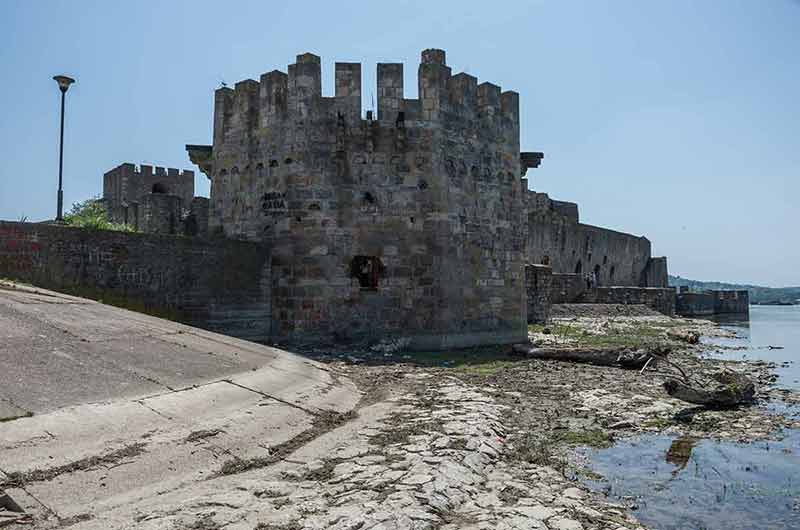
Smederevo is on the right bank of the Danube in east Serbia, just 45 km (27.9 miles) downstream of Belgrade.
As in many Serbian towns, there is a 15th-century fortress that was used as protection against invading forces, with an impressive 25 towers.
The space inside the fortress is a lovely green park where you can stroll.
Walk the length of the walls and enjoy the lovely city and Danube views.
Republic Square is the city’s centre, towered over by the Church of Saint George, dating back to the 1850s.
It has an impressive total of five 12-sided domes, a prime example of Byzantine architecture.
However, the church’s facade is Baroque, with little touches of Islamic architecture.
Starting next to the Danube and going all the way to Republic Square is the main street, Ulica Kralja Petra 1, which is shut off to road traffic.
It is where the locals gather to take an early evening promenade and to take advantage of the many cafes, bars, and restaurants.
In the summer, outdoor seating takes over the street.
Recommended tour: From Belgrade: Danube Day Trip with Wine and Brandy Tasting
8- Zrenjanin
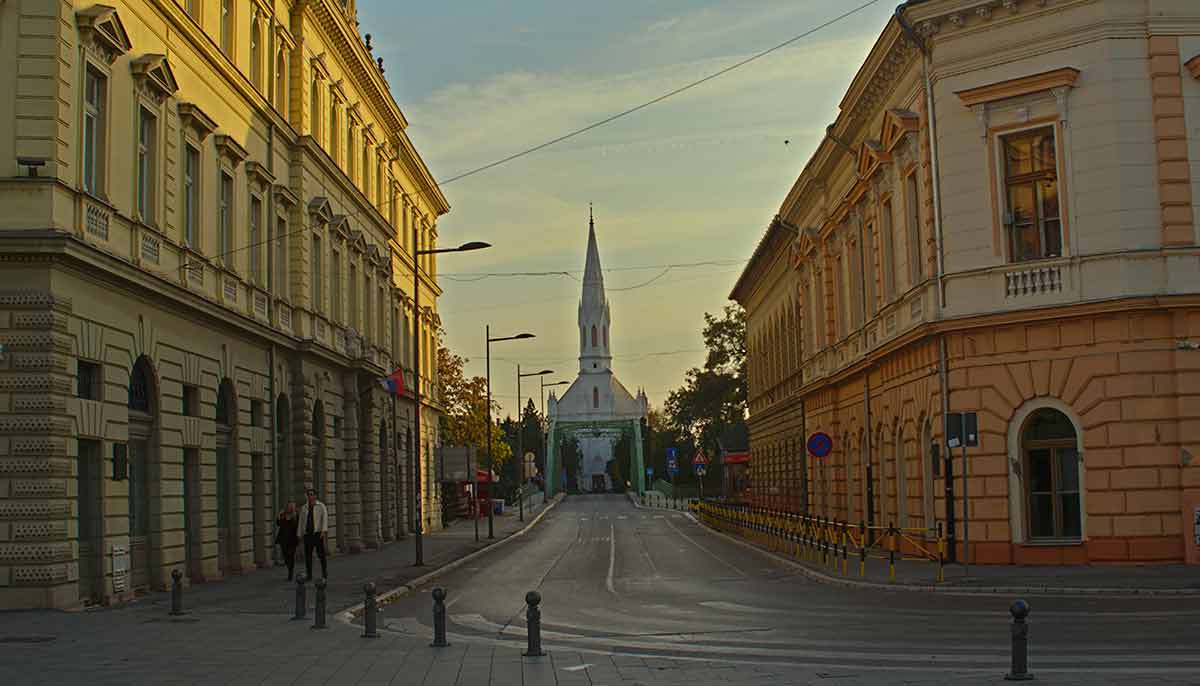
Zrenjanin is in northern Serbia and is in the Vojvodina Plains.
Most of the Old Town is pedestrianised and has an excellent selection of shops and cafes, especially on King Alexander Street.
Trg Slobode, or Freedom Square, is the focal point where you will find the Town Hall, the main library, the Cathedral, the National Theatre and the old Stock Exchange.
The Stock Exchange is worth taking a photo of as it is very impressive, designed in Neoclassical style.
It now houses the National Museum, where you will find 8,400 years of the city’s history and the surrounding area.
The Cathedral of St John of Nepernuk sits where the old mosque used to be during Ottoman rule.
When the Austro-Hungarian Empire took over the city in the 18th century, they destroyed the mosque and built the church.
However, it was rebuilt in the following century in the Neo-Romanesque style.
Go inside and see the magnificent organ and the beautiful stained-glass windows.
The National Museum is at Subotica 1 23000.
9- Sombor

Sombor is in the country’s northwest, bordering Hungary to the north and Croatia to the west.
In Serbia, Sombor is called ‘The Green Town’ because it has many parks and tree-lined avenues.
The main street is Glaonjak, where the locals gather to meet friends for a coffee or a meal.
You’ll find plenty of shops here if you want to take home some souvenirs.
Much of the architecture is Baroque style and worth photographing.
The City Hall is also worth a click on your camera as it has a beautiful facade.
You must go inside as it houses an enormous painting by Franz Eisenhut, the largest in the country.
It depicts the Battle of Senta when the Ottoman Empire was defeated in 1697.
One of the country’s best galleries for contemporary art is in Sombor.
The Milan Konjovic Gallery holds 500 pieces by the Serbian artist of the same name.
The Milan Konjovic Gallery is at Trg Trojsta 2 251010.
Recommended tour: From Belgrade Tour to Lake Palic, Subotica and Sombor.
10- Pozarevac
Pozarevac is 70 km (43.5 miles) away from Belgrade.
It is another hip city with a fantastic nightclub scene.
However, it has plenty to occupy you during the day.
There is a gallery dedicated to the Serbian painter Milena Pavlovic Barritti in the house she was born in.
She died, unfortunately, too early, so who knows what other great works she might have produced.
There is a museum in the city housing 50,000 artefacts relating to the city’s history.
The main building holds the archaeological, prehistoric, and antique collections area, while there is a lapidarium in the courtyard, exhibiting sculptures and tombstones.
Close to Pozarevac are the ruins of the ancient Roman city of Viminacium, where you can see military weapons dating back to that time, as well as cesspits, an amphitheatre that was used for gladiatorial events, and a hippodrome that was used for chariot racing.
The Gallery is at Voje Dulica 14 12000.
The Museum is at Voje Dulica 10 – 12 12000.
Exploring Eastern Europe? You may also like:
- 20 Landmarks in Bulgaria
- 20 Bulgarian Cities
- 20 Things To Do In Sofia
- 22 Landmarks in Hungary
- 20 Cities in Hungary
- 15 Things Hungary Is Famous For
- 22 Castles in Czech Republic
- 21 Landmarks in Czech Republic
- 20 Things To Do In Prague At Night
- 15 Things To Do In Prague
- 20 Day Trips From Belgrade
- 10 Things To Do In Belgrade
- 20 Cities in Serbia
- 20 Things To Do In Baku
- 20 Slovakian Cities and Towns
- 20 Slovenian Cities and Towns
- 20 Latvian Cities and Towns
- 20 Castles in Poland
- 20 Landmarks in Poland
- 20 Polish Drinks
- 20 Cities in Poland
- 20 Things To Do In Warsaw
- 20 Things To Do In Krakow
- 20 Things To Do In Krakow At Night
- 20 Things To Do In Gdansk
- 20 Castles in Romania
- 20 Landmarks in Romania
- 20 Cities in Romania
- 20 Castles in Belarus
- 20 Things To Do In Tbilisi
- 20 Things To Do In Armenia
- 20 Cities In Armenia
- 20 Things To Do In Riga
- 20 Things Romania Is Famous For
11- Sremska Mitrovica
Sremska Mitrovica is one of Europe’s oldest cities.
Sitting on the left bank of the Sana River, its rich history dates back to 5,000 BC.
It was one of four capitals of the Ancient Roman Empire and was then known as Simnium.
The Museum of Stremska Mitrovica is worth a visit.
Founded in 1885, it houses archaeology, history, nature, and ethnology artefacts.
Sremska Mitrovica is a good base to explore The Special Nature Reserve of Zasavica.
It’s right next door.
It is one of the last authentically preserved wetlands in Serbia.
Here, you can find around 600 different types of flora.
216 bird species, 20 types of fish, 65 mammal species, and 27 amphibians and reptiles.
Recently, it has become popular due to the reintroduction of beavers.
An impressive Visitor’s Centre in the Reserve has an Ethnic Room showing old household, agricultural equipment, and books from the 19th and early 20th centuries.
The restaurant is convenient for taking a break from hiking around the reserve.
There is a camping site for motorhomes with water and electricity supplied.
The Museum of Stremska Mitrovica is at two sites, Trg Svetag Stefana 15 and Vuka Karadzica 3 21001.
The Special Nature Reserve of Zasavica is at Svetog Sau 19.
12- Vrsac
Vrsac is close to the Romanian border and is a small city that’s easy to explore on foot.
Some beautiful buildings represent different architectural styles, particularly Baroque and Secession styles.
Surrounding the city are many vineyards producing excellent Serbian wines such as Kreaca, Smederkevka and Zupyanka, where you will find high-quality wine.
Vrsac Castle overlooks the city and offers stunning views of the surrounding countryside and city.
It dates back to 1439 and has been going through reconstruction, so it is worth visiting to soak up some 15th century.
Visit the Vrsac National Museum, which houses many archaeological artefacts.
View artworks from the 19th and 20th centuries and enjoy the large ethnographic collection.
The National Museum is at Bulevar Zarka Zrenjanina 20 26300
13- Nis
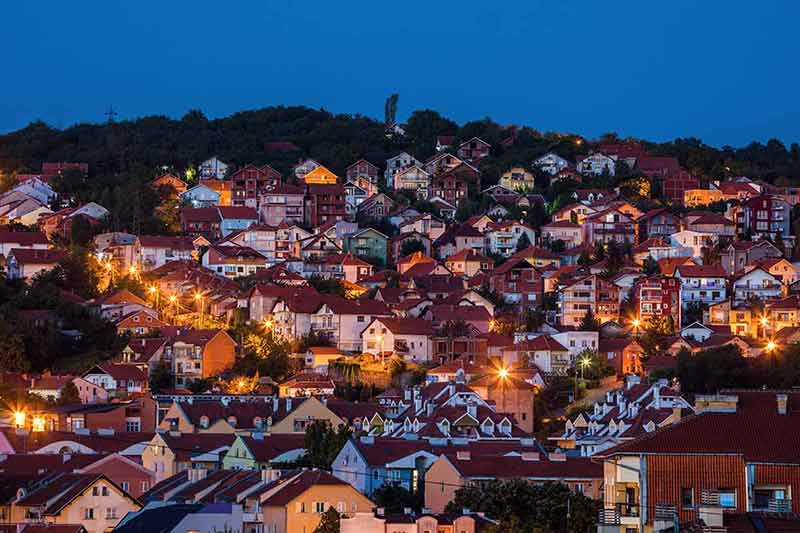
Nis is in the country’s south and is the third-largest city in Serbia.
It is an ancient city going back as far as Ancient Rome, with several Roman Emperors born here.
The Ottomans later ruled it, and you can see signs of both occupations in the city.
A giant Ottoman Fortress, completed in 1723, dominates the city.
It encloses an ancient Roman citadel founded 2,000 years ago, which covers 22 hectares.
In the Fortress, you will see a Turkish hammam from 1498, the mosque, Bali-Behy, from 1521, a lapidarium with Roman tombstones, and a monument commemorating the liberation of Nis in 1902.
There is a horrible reminder of the 1st Serbian uprising in the early 19th century in Skull Tower.
Here were placed 952 Serbian skulls, the people killed by the Ottomans.
When the Ottomans withdrew in 1878, most of the skulls were buried, but there is a remnant of the tower with 54 skulls housed in a chapel.
There are other reminders of atrocities committed in the city.
The Crveru Krst Concentration Camp has been preserved as a memorial to the Jews, Serbians, and Romanians imprisoned here by the Nazis.
It hasn’t been touched since then and has an eerie quiet feel surrounding it.
You can also visit the Bubary Memorial Site, where approximately 10,000 prisoners from the camp were murdered.
On a lighter note, Nis has many trendy cocktail bars and a lively music scene.
Recommended:
14– Kraljevo
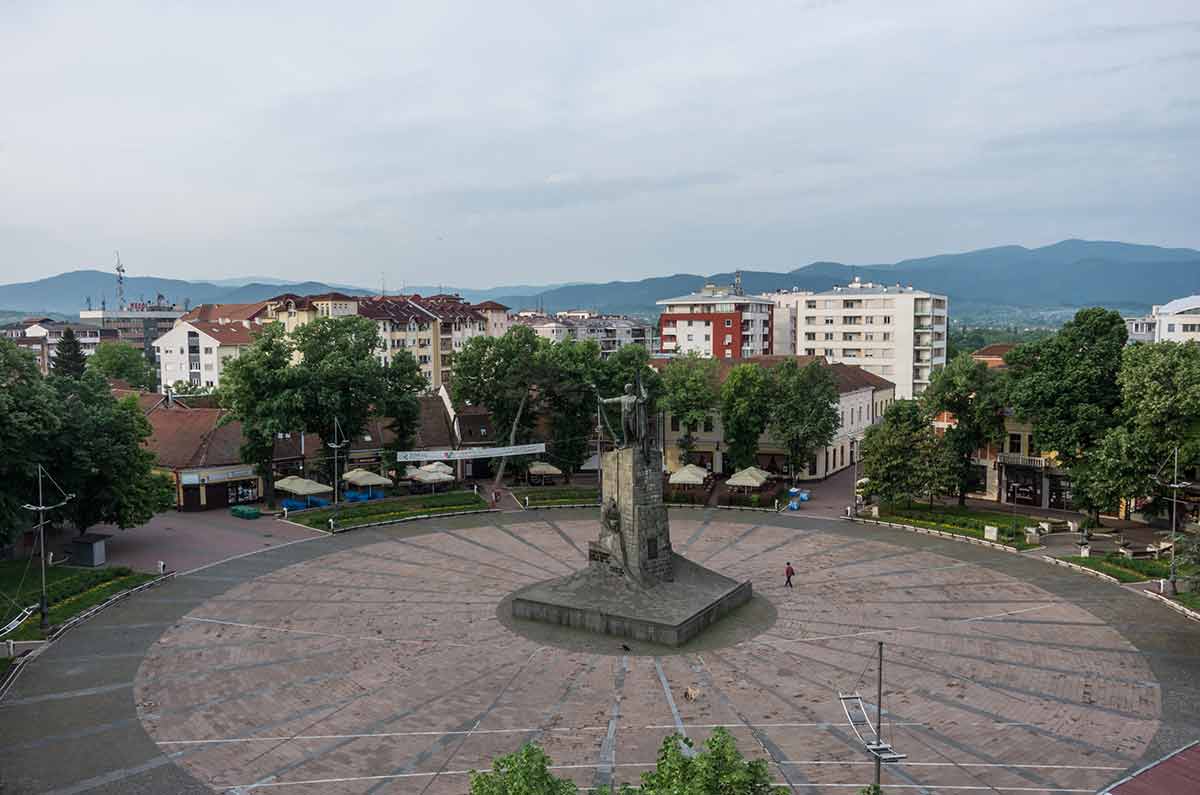
Kraljevo is in the centre of the country and is a small city with lots of potential.
Its main square, the Square of Serbian Warriors, has one of the largest sundials on the continent and a bronze statue of a soldier created in honour of those who died in the First World War.
Leading off the square is Omladinska Street, where the locals take advantage of the many cafes, bars and restaurants.
The Church of the Holy Trinity here has stood through all the history of the city and is the oldest building in Kraljevo,
Head outside the city and discover some beautiful monasteries such as Studenica and Zica.
They date back to Mediaeval times and have beautiful frescoes and lovely architecture.
20 km (12.4 miles) from the city is Maglic Fortress which has ancient fortifications and beautiful views over the Iber River, where you can white water raft.
15- Kragujevac
This industrial city is the fourth-largest city in Serbia and is situated along the Lepenica River.
A must-see is Sumance Memorial Park, where, on October 21st, 1941, 3,000 men and boys aged between 16 and 60 were rounded up and shot because Partisans and Chetniks killed 10 German soldiers.
In the 1960s, the Serbian artist Miodrag Zukovic created a series of sculptures remembering them.
In the park, the Sumanice Museum is an unusual building made from red bricks, signifying the blood of the men massacred.
Inside the buildings, there aren’t any windows that heighten the feelings of despair.
The massacre has inspired the paintings and sculptures housed in the museum.
There is also a memorial room dedicated to the lives lost.
The haunting backlit images of the victims will send shivers down your spine.
Kragujevac is a lively and youthful city away from Memorial Park, with plenty of restaurants and bars that won’t break the bank.
16- Novi Pazar
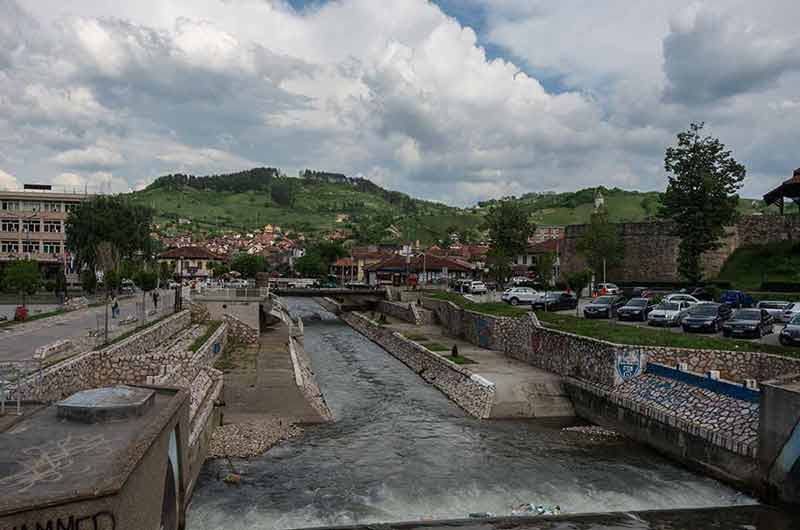
Novi Pazar is in southwestern Serbia but you will almost think you are in Turkey.
There is a minaret in the city’s centre and the population is approximately 80% Muslim.
The city is often referred to as ‘mini-Istanbul’.
The Altun-Alem Mosque dominates the city with its high brick walls.
There is a Maktab (a school) inside and a courtyard filled with tombstones.
The Mosque has a minaret with a large single dome fronted by two smaller domes and a gallery carved from wood.
There is a hammam which is common in Turkey.
The Stasi Ras is another dominant feature of the city.
It is a fortress and UNESCO World Heritage Site situated on the confluence of the Raska and Sebecvo rivers.
It was the Serbian capital from the 700s until the 1200s, when it was abandoned.
Also, part of this UNESCO Site is the Orthodox Christian Sopocani Monastery built in the 13th century and shows off lovely frescoes, an exceptional example of Byzantine art.
Other monasteries in the city area include the Durdevi Stupovi built in the 12th century.
The highlight of this monastery is St George’s Church, a magnificent example of Romanesque and Byzantine art and architecture.
There are some beautiful frescoes in the church.
17- Uzice

Uzice in western Serbia is a proud city that fought against the Nazis in WWII and created The Republic of Uzice.
Although this only lasted for 67 days, it is not forgotten, and the National Museum is dedicated to this achievement.
Underneath the museum, there are underground tunnels that were used for the construction of weapons during the last world war.
You can tour the tunnels but don’t go if you are claustrophobic, as they are narrow and dark.
In the museum, there’s the largest statue of Tito, the now-deceased president of the former Yugoslavia.
The 13th-century Old Town sits high on a hill with spectacular views over the city.
Head to Partisan Square where the locals enjoy life in cafes and restaurants.
The National Museum is at Dimitrija Tucovica 18.
18- Pirot
Pirot is in the country’s southeast and is surrounded by spectacular mountains.
It is a beautiful city with many rivers and four lakes and has many photographic opportunities.
The 14th-century Pirot Fortress is the highlight of this Serbian city and used to be the Old Town.
The water ditches and stone walls give you an idea of life in Mediaeval times.
The Museum of Ponisavlja is within the beautiful oriental house of the famous Serbian family, the Ristics.
The 19th-century building houses old pottery, bright and colourful carpets, and Oriental and Slavic architecture.
Just outside the city is the Nature Park Stara Planina, and above the city is the beautiful resort of Basarski Karmen situated in the mountains.
Here you can hike.
Although it takes around an hour and a half to make the journey, you will be rewarded with spectacular views.
In the Nature Park, you’ll find beautiful waterfalls, the Tupavica Vodopad and at Rayovac, there is a beautiful canyon with crystal clear water.
19- Krusevac
Krusevac is in central Serbia and is best known for Prince Lazar, who led the Serbs during The Battle of Kosovo in 1389 against the Ottomans.
Prince Lazar was killed in action, and the Serbs were defeated.
Krusevac was then the capital but all that remains of this time is the Donzan Tower, a monument to Prince Lazar.
In the city, you will find the Lazarica Church, a perfect example of Mediaeval architecture, and the National Museum.
Krusevac has a youthful population who head to Zakviceva Street in the evenings to spend time in the bars and clubs.
The atmosphere is lively and vibrant.
20- Cacak
Cacak is situated in the country’s centre, surrounded by high mountains and the Ovcar-Kablar gorge.
You can hike in the gorge but be warned that it is 20 m (12.4 miles) long.
However, there are also monasteries to visit, most built in the 16th or 17th centuries.
The monastery you should visit is the Monastery of the Annunciation of the Virgin Mary, which has some beautiful frescoes.
You should also visit the Kadenica cave church, where you can see the remains of Serbians killed by the Ottomans in sarcophaguses beneath the altar.
Visit the National Museum Cacak, which houses artefacts relating to the city going back many years.
If you want to see local life, head to Gradsko Setal, the main street in the city.
You can eat, drink, and even indulge in exotic ice cream at one of the many parlours.
The street is bustling and hyped up on a warm summer evening.
For more cities in Europe, read:
- 20 Best Cities in Greece
- 20 Best Cities in Poland
- 20 Best Cities in Spain
- 20 Best Cities in Portugal
- 20 Best Cities in Turkey
- 20 Best Cities in Scotland
- 20 Best Cities in Italy
- 20 Best Cities in Ireland
- 20 Best Cities in Germany
- 20 Best Cities in Austria
- 20 Best Cities in Wales
- 20 Best Cities in Hungary
- 20 Best Cities in Serbia
- 20 Best Cities in Bulgaria
- 20 Best Cities in Slovakia
- 20 Best Danube River Cities
- 20 Best Cities in Romania
- 20 Best Cities in Finland
- 20 Best Cities in France
- 20 Best Cities in Switzerland
- 20 Best Cities in England
- 20 Best Cities in Iceland
- 20 Best Cities in Netherlands
- 20 Best Cities in Belgium
- 20 Best Cities at Night
- 20 Best Cities in Croatia
- 20 Best Cities in Denmark
- 20 Best Cities in Norway
- 20 Best Cities in Sweden
- 20 Best Cities in Slovenia
- 20 Best Cities in Latvia
Plan Your Trip

Rent A Car – Find the best car rental rates at Discover Cars. They compare car hire companies to provide you with the best deal right now.

Find A Hotel – If you’re curious about this article and are looking for somewhere to stay, take a look at these amazing hotels.

